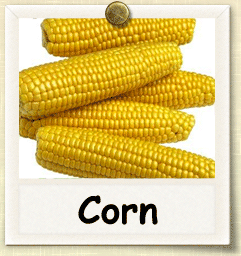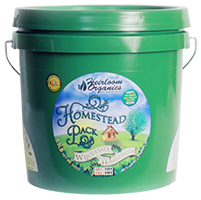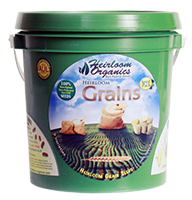|
Home > Guides > Grains > Corn |
|
How to Grow Corn | Guide to Growing Corn |
|
|
|
|
| |
 |
|
Overview |
|
|
|
|
|
| |
|
| |
Corn demands fertile soil, consistent moisture and warm weather. If you have those and plenty of garden space to spare, it’s not hard to grow great-tasting corn, and you won’t get it any fresher. |
|
| |
|
|
| |
Growing Guide
GROWING NOTES
Needs deep, well-drained, fertile soil, pH 6.0 to 6.8 and consistent, plentiful moisture.
Tender annual
Requires excellent soil and consistent moisture.
Otherwise, it's not difficult to grow.
MAINTAINING
Corn requires rich, fertile soil. Add compost or well rotted manure in fall. Consider planting a legume cover crop the season before corn to help meet the nutrient needs of this heavy feeder.
Make first planting after last frost date. Soil should be at least 65 F for fast germination. (Corn will not germinate if soil temperature is less than 55 F.) To speed increase in soil temperature, consider covering soil with black plastic for several weeks before planting.
Plant in blocks of at least 4 rows of a single hybrid (as opposed to fewer, longer rows) for good pollination and well-filled ears. (Some corn varieties need to be isolated from others. See variety information below.)
Plant seeds 1 inch deep and 4 to 6 inches apart in rows 30 to 36 inches apart. Thin to 8- to 12-inch spacings when plants are 3 to 4 inches tall. Increase seeding rates to ensure a good stand if soils are cold or you are using seed that has not been treated with fungicide. (Untreated seed has natural color. Treated seed is dyed.)
For a sequential harvest, make first planting using an early hybrid. Two weeks later, plant another block of an early hybrid, plus blocks of mid- and late-season hybrids. Continue making plantings until late June or early July, depending on the length of your growing season.
To save space, you can intercrop corn with early-harvested cool-season crops.
Corn plants have many roots close to the surface, so cultivate around them with care. You can hill soil up around the base of plants as they grow to bury small weeds in the row and give the corn a better foothold. After the soil has warmed, you can mulch corn to help suppress weeds and retain moisture.
It is not necessary to remove suckers (side sprouts growing from the base of the plant). Studies show that removing them may actually reduce yields.
Corn is a heavy feeder - particularly of nitrogen - and may require several sidedressings of fertilizer for best yields. Look for signs of nutrient deficiency. Purple-tinged leaves are a sign of phosphorus deficiency. Pale green leaves are a sign of nitrogen deficiency.
For miniature or baby corn, plant seeds 2 to 4 inches apart and harvest as silks emerge from the ear, or harvest secondary ears from normally spaced plantings, allowing the main ear to fully mature. Also try hybrids specifically bred for early baby corn harvest.
|
|
| |
|
| |
Heirloom seeds are the gardeners choice for seed-saving from year-to-year. Learning to save seeds is easy and fun with these books. Before you harvest, consider which varieties you might want to save seeds from so that your harvesting practice includes plants chosen for seed saving. Be sure to check out our newest seed packs, available now from Heirloom Organics. The Super Food Garden is the most nutrient dense garden you can build and everything you need is right here in one pack. The Genesis Garden s a very popular Bible Garden collection. The Three Sisters Garden was the first example of companion planting in Native American culture. See all of our brand-new seed pack offerings in our store.
|
|
| |
|
|
| |
Harvesting Guide
HARVESTING
Of all the vegetables grown, corn is the one most often harvested too late. With corn, it is essential to pick it at the right time to get the best quality and flavor. Corn also starts to lose its quality quickly after it is harvested. Within 24 hours after being picked, most corn loses more than half its natural sugars by converting them to starch. Ideally, you should harvest your corn at the time you are ready to cook it.
Check sweet corn for ripeness when the the silks have turned brown but are still damp to the touch. Pull back the husk partially and puncture a kernel. If a clear liquid spurts out, the corn isn`t ready. If a milky liquid spurts out, it is ready and should be picked immediately! If no liquid emerges, the corn is past its prime.
Beware, however, that though pulling back the husks is a reliable method of checking for ripeness, it does have a major disadvantage if the corn is still immature when you do the checking. Once you open an immature ear, it becomes susceptible to insect and other pests, as it continues to ripen. Attack by birds also becomes more likely. With a little experience and practice, you'll be able to judge the ripeness of corn fairly accurately, just by feeling the ends of the ears and not have to worry about that problem. Good seed should be viable for at least two years.
SAVING SEEDS
To save corn seed choose the earliest and the best-developed corncobs you can find. Cover them with a large enough paper bag to be able tie the top off to keep the bugs and grubs out. Do not use a plastic bag as the cob needs to breathe. Allow the cob to develop and dry out on the stalk as long possible. To store the cobs, remove them from the bag, pull back the husks, and hang in a dry area away from bugs or rodents, or you will end up with a dried out corncob with no seed. When the cobs are fully dried out, carefully break-off the seed, store in a paper bag, and keep in a cool place (the bottom of the fridge is a good spot) until springtime and you want to sow it.
|
|
| |
|
|
|
| |
|
|
|
|
|
| You can find this variety in the following Seed Packs: |
|
  
   |
|
| Click the packs below to see some of our other wonderful products |
|
|
|
|
|
|
|